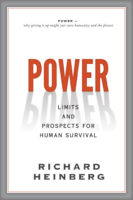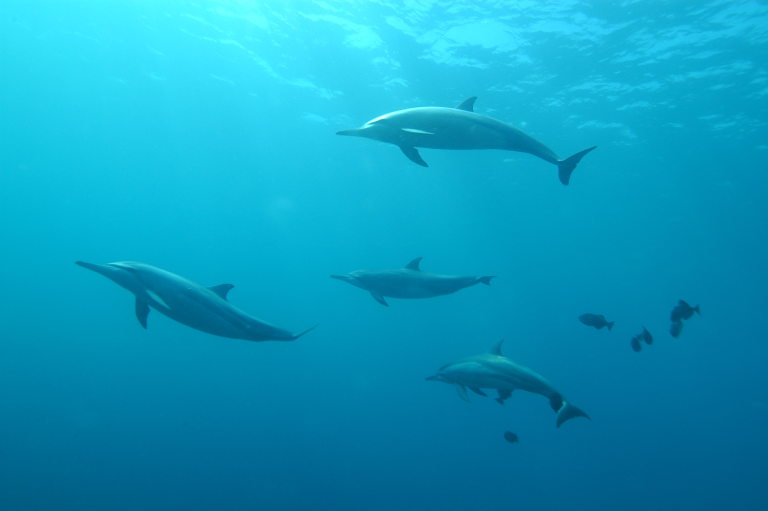 This is an abridged excerpt from Power: Limits and Prospects for Human Survival (2021) by Richard Heinberg; posted with permission from New Society Publishers.
This is an abridged excerpt from Power: Limits and Prospects for Human Survival (2021) by Richard Heinberg; posted with permission from New Society Publishers.Read more in this series.
Powers That Derive from Being a Specialist or a Generalist
Specialist species get better and better at exploiting a certain type of food within a specific environment. Perhaps the most famous example: when Darwin arrived on Galapagos Island in 1836, he found 15 species of finches, each of which had evolved a different form of beak for opening a particular kind of seed available on the island.
Generalists do many things, but are typically champions at none. Humans, crows, cockroaches, rats, and racoons are all generalists, and are able to eat a wide variety of animal and plant foods.
Specialists have the advantage of being able to out-compete most other creatures that would otherwise take advantage of a targeted food source. The risk of specialization is that if the preferred food source is suddenly less abundant, the organism may have difficulty adapting. Generalists tend not to use any particular resource very efficiently. But, because they can harness a wider range of resources, generalists may have a power advantage in a varied, unpredictable, or rapidly changing environment.
There are fewer generalist than specialist species, but some generalists (such as crows and rats) are abundant and wide-ranging. One generalist species, Homo sapiens, has become especially abundant and wide-ranging, and hence collectively powerful, for reasons we will explore in the next three chapters.
The Power of Cooperation
…[E]volution works not just by fierce competition, but also—perhaps even more so—by cooperation. Ironically, organisms that develop ways to cooperate often thereby derive a competitive advantage: working together, many individuals can become more powerful than they would be if working in isolation.
Nature offers innumerable examples of cooperative behavior; indeed, without it, there would be no multicellular organisms. We’ve already seen how eukaryotes are the result of an ancient symbiosis between two very different kinds of cells. Green plants—containing both mitochondria and chloroplasts—are double symbionts.
At the macro scale, cooperation among members of the same species is seen in ants, honey bees, fish that “school” (such as herring), prairie dogs, members of the canine family, many bird species, and all primates (this is only a partial list).
Cooperation between members of different species is also common. Many flowering plant species have evolved cooperative relationships with specific pollinators, in which both participants benefit. Sometimes smaller animals work out cooperative relationships with larger ones—such as cleaner fish (including cleaner wrasses, neon gobies, and some catfish) that feed on dead skin and parasites on larger predatory fish that could easily eat the cleaners, but don’t.
Extreme cooperation can lead to extreme power. Ants, the most cooperative organisms on the planet until civilized humans came along, are one of the most successful groups in evolutionary history and account for about a third of all insect biomass. Humans, because they are extraordinarily cooperative, are able individually to specialize to an astonishing degree, thereby enabling Homo sapiens to take advantage of both generalist and specialist strategies to an extent unmatched elsewhere in nature.
Tool Power
Animals and plants obtain and exert many of their powers by developing parts of themselves for a particular purpose—such as a wing ideal for soaring on wind currents, or a tail perfect for swinging from tree branches. One way of understanding tools is to think of them as detachable organs. Since tools are not part of the organism and can be replaced or modified at will, an organism can use different tools for different purposes.
Decades ago, most scientists thought that the ability to make and use tools was uniquely human, but this attitude has gradually changed. Researchers were initially curious to see if other primates used tools. Chimps, for example, were observed to have specialized tool kits for hunting ants. … However, nonhuman primates may not be the best examples of animal tool users. Crows have been observed modifying twigs, leaves, and their own feathers to serve as tools. … Bottlenose dolphins in Shark Bay, Australia, carry marine sponges in their beaks to stir the sand on the ocean floor to uncover prey. It’s said that they spend more time hunting with tools than any other nonhuman animal. … The net-casting spider weaves a small net, attaches it to its front legs, then waits for potential prey. When the victim arrives, the spider lunges forward to wrap the net around it, then bites and paralyzes its prey. Observed in any mammal, similar behavior would almost certainly be described as the making and use of a tool.
Trade-Offs of Specialization
As we’ve seen, organisms have developed amazing abilities. Why isn’t every organism good at everything? Because getting really good at one thing tends to hamper your ability to do something else. To put it more formally, the extreme expression of any given trait is likely to reduce fitness in some way. The giraffe’s long neck enables it to browse on the leaves of trees, but makes it highly vulnerable to predators when it needs to bow low to drink water. A bacterial mutation that confers resistance to an antibiotic may weaken the bacteria if that antibiotic isn’t present. The bat can hear certain frequencies with extraordinary acuity, but if it simultaneously had the eyesight of a hawk, the ability to sense infrared radiation the way a pit viper does, and the ability to see ultraviolet colors the way many birds do, its brain would have to be very large and would likely be overloaded with stimuli.
Generally, if the benefits of an extreme specialization outweigh the costs and the organism is able to survive and reproduce, the extreme ability will be preserved; if the costs outweigh the benefits, evolution will de-emphasize the specialization or the organism will fade away and evolution will move on.
All of this suggests there are probably downsides to humans’ specialized powers (extreme intelligence, a highly developed ability to communicate, and proficient tool use). We humans tend to emphasize the advantages of these traits, but it’s always important to look for hidden costs. We’ll be discussing these evolutionary costs at some length in later chapters.
Read more in this series.
Photo by Rudney Uezu on Unsplash






